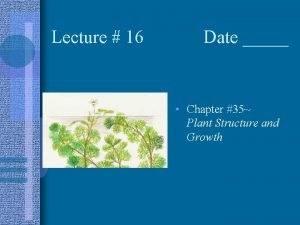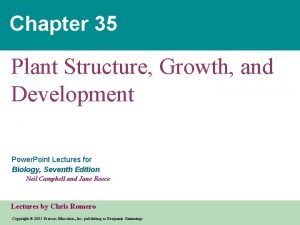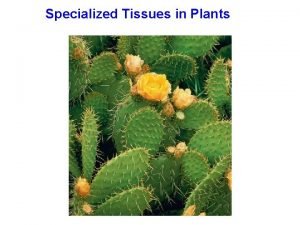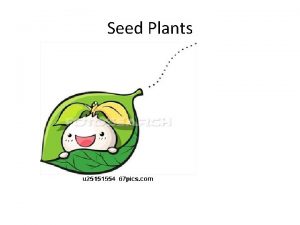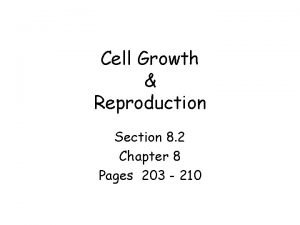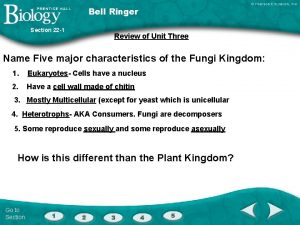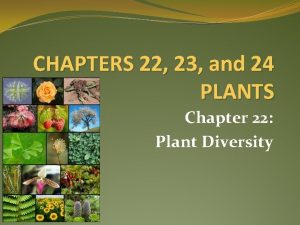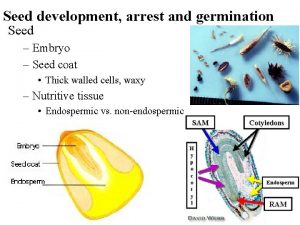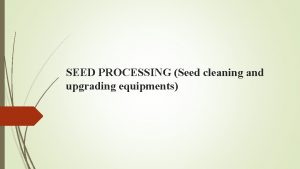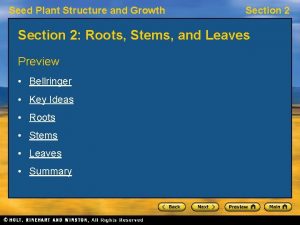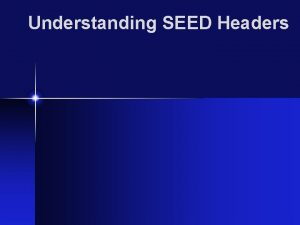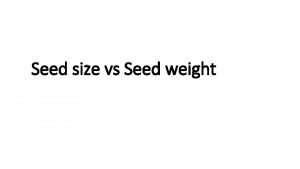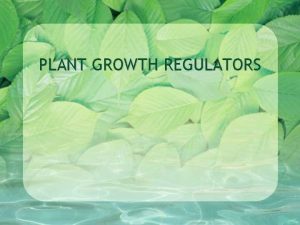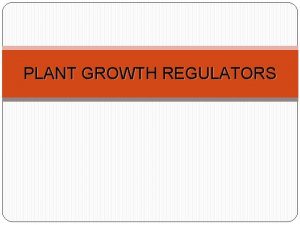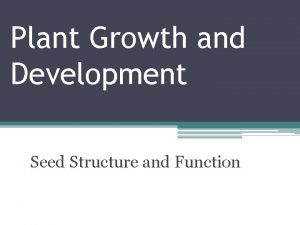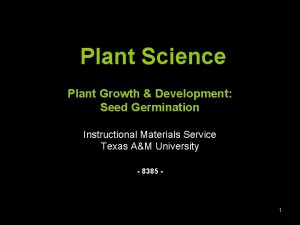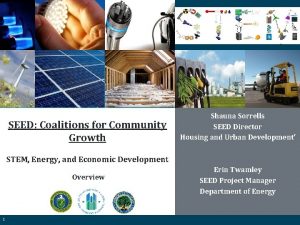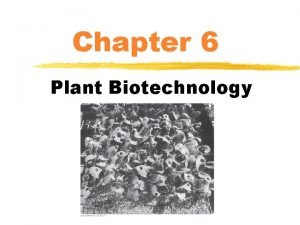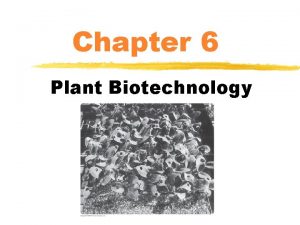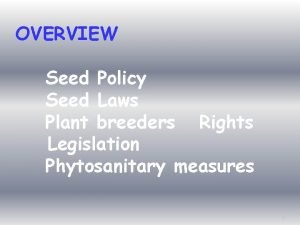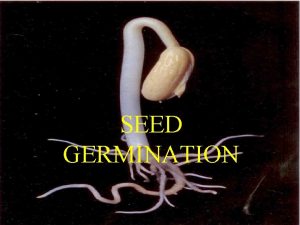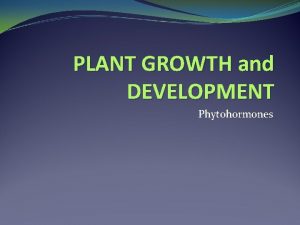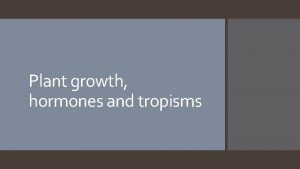Seed Plant Structure and Growth Section 3 Plant




















- Slides: 20

Seed Plant Structure and Growth Section 3: Plant Growth and Development Preview • Bellringer • Key Ideas • The Plant Embryo • Meristems • Primary Growth • Secondary Growth • Summary Section 3

Seed Plant Structure and Growth Section 3 Bellringer Observe a cross-section of a tree trunk. How might the rings form? Why they are called “annual rings? ”

Seed Plant Structure and Growth Section 3 Key Ideas • What are the characteristics of a seed plant embryo? • How do meristems relate to plant growth? • What is the result of primary growth on a plant? • What is secondary growth, and what type of meristem is involved?

Seed Plant Structure and Growth Section 3 The Plant Embryo • As in animals, genes guide the development of plants, but the patterns of development in plants and animals are very different. • Plants continuously make new cells, which differentiate and replace or add to existing tissues. • A seed develops from an ovule and contains a plant embryo.

Seed Plant Structure and Growth Section 3 The Plant Embryo, continued • The plant embryo possesses an embryonic root and an embryonic shoot. • Leaflike structures called cotyledons, or seed leaves, are attached to the embryonic shoot. • In angiosperms (flowering plants), embryos have one or two cotyledons. Monocots have a single cotyledon, and dicots have two cotyledons.

Seed Plant Structure and Growth The Plant Embryo Section 3

Seed Plant Structure and Growth Section 3 The Plant Embryo, continued • The process by which a plant embryo resumes its growth after a period of suspended animation, or dormancy, is called germination. • Seeds sprout in response to certain changes in the environment. • Changes such as rising temperature and increasing soil moisture usually signal the start of favorable growing conditions. • Some seeds must be exposed to cold, fire, or damage before they can sprout.

Seed Plant Structure and Growth Seed Germination Section 3

Seed Plant Structure and Growth Section 3 Visual Concept: Germination of a Dicot

Seed Plant Structure and Growth Section 3 Visual Concept: Germination of a Monocot

Seed Plant Structure and Growth Meristems • Plants grow by producing new cells in regions of active cell division called meristems. • Meristems are made up of undifferentiated cells that divide and can develop into specialized tissues. Section 3

Seed Plant Structure and Growth Section 3 Meristems, continued • Growth that increases the length or height of a plant is called primary growth. • The tissues that result from primary growth are primary tissues. • Growth that increases the width of stems and roots is called secondary growth. • The tissues that result from secondary growth are secondary tissues.

Seed Plant Structure and Growth Visual Concept: Meristem Section 3

Seed Plant Structure and Growth Section 3 Primary Growth • Apical meristems, which are located at the tips of stems and roots, produce primary growth through cell division. • The new cells produced by apical meristems differentiate into the primary tissues of roots, stems, and leaves. • Primary growth makes a plant’s stems and roots get longer without becoming wider. • Each branch of a stem and each branch of a root has its own apical meristem that produces new primary tissues as the branch grows.

Seed Plant Structure and Growth Section 3 Visual Concept: Primary Growth in Plants

Seed Plant Structure and Growth Section 3 Secondary Growth • Some of the undifferentiated cells that are left behind as stems and roots lengthen and produce lateral meristems. • Lateral meristems are responsible for increases in the width of stems and roots. This increase is called secondary growth. • The two lateral meristems responsible for secondary growth are called the cork cambium and the vascular cambium.

Seed Plant Structure and Growth Secondary Growth in Plants Section 3

Seed Plant Structure and Growth Section 3 Visual Concept: Secondary Growth in Plants

Seed Plant Structure and Growth Section 3 Summary • The plant embryo possesses an embryonic root and an embryonic shoot. Leaflike structures called cotyledons, or seed leaves, are attached to the embryonic shoot. • Plants grow by producing new cells in regions of active cell division called meristems. • Apical meristems are responsible for primary growth, which makes a plant’s stems and roots get longer without becoming wider.

Seed Plant Structure and Growth Section 3 Summary, continued • Lateral meristems are responsible for increases in the width of stems and roots. This increase is called secondary growth.
 Chapter 35 plant structure growth and development
Chapter 35 plant structure growth and development Xylem und phloem
Xylem und phloem Vascular ray
Vascular ray Structure of leaf
Structure of leaf Growth analysis definition
Growth analysis definition Monocot vs eudicot
Monocot vs eudicot Primary growth and secondary growth in plants
Primary growth and secondary growth in plants Things that have roots
Things that have roots Step growth polymerization vs chain growth
Step growth polymerization vs chain growth Geometric growth graph
Geometric growth graph Neoclassical growth theory vs. endogenous growth theory
Neoclassical growth theory vs. endogenous growth theory Organic growth vs inorganic growth
Organic growth vs inorganic growth Crop calendar for rice
Crop calendar for rice Functions of ethylene
Functions of ethylene Functions of seeds in plants
Functions of seeds in plants How does iago plant the seed of jealousy in othello?
How does iago plant the seed of jealousy in othello? How does iago plant the seed of jealousy in othello?
How does iago plant the seed of jealousy in othello? Seed plants are divided into two groups. what are they?
Seed plants are divided into two groups. what are they? Chapter 8 cell growth and division section 8-2 answer key
Chapter 8 cell growth and division section 8-2 answer key Section 22-4 seed plants
Section 22-4 seed plants Section 22-4 seed plants
Section 22-4 seed plants
